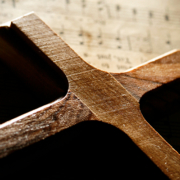Don’t forget Advent
In the midst of Christmas chaos and crowds, Advent points us to what is important.
Stephen M. Luchterhand
The countdown for next Christmas began the day after Christmas last year—364 days until Christmas. (It’s 365 days this coming year, thanks to a leap year in 2020.) Of course, Christmas stays under the radar as other holidays, birthdays, and milestones are observed. Yet savvy planners and shoppers deposit money into savings accounts, watch sales, and examine trends with an eye on December and Christmas.
Later in the year the leaves begin to change color in America’s northern regions, and the taste of pumpkin invades almost every food and drink concoction imaginable. At that point, retailers quietly begin setting out Christmas trees, ornaments, and decorations. Excitement over Christmas builds slowly, but steadily, until Thanksgiving. Then it’s pandemonium.
Christmas trees and decorations go up inside homes and businesses. Lights and displays appear outside homes and businesses. Black Friday unleashes stampedes of shoppers. Cyber Monday extends the chaos online. It’s the “all shopping, all the time” race to Christmas: in-store shopping, online shopping, two-day shipping, next day shipping, free shipping. FedEx, UPS, and the USPS are everywhere. Children receive the message, either directly or indirectly, that good behavior will merit more gifts under the Christmas tree.
In the midst of all the distractions and diversions, the season of Advent intervenes.
Proper preparation
“Advent” is a Latin word that means “coming” or “arrival.” The Christian church year begins with the first Sunday in Advent at the end of November or beginning of December and continues for four Sundays until Christmas. The Advent season quite naturally helps Christians prepare to celebrate Jesus’ first coming at Christmas. The four Sundays of Advent offer a powerful spiritual antidote to the commercialism and busyness of our modern Christmas celebrations.
The readings and hymns of Advent help us to prepare for the celebration of our Savior’s birth and point us to the Savior’s second coming on the Last Day. Visual cues in worship direct attention to the themes and the emphases of the season. Currently blue (or purple) altar paraments and pastors’ stoles symbolize hope. Sanctuary Advent wreaths feature a white Christ candle encircled by four candles highlighting Advent themes. The three blue (or purple) candles symbolize hope, love, and peace. The pink candle, lit during the third week of Advent, symbolizes joy.
But nothing prepares the heart for proper Advent celebration more than the arrival of John the Baptist. While media and culture promote the fun of a “holly, jolly Christmas” and Santas belting out their friendly “ho-ho-hos,” along comes John to tell us that we’re doing it all wrong.
To the casual observer, John is the Grinch who steals holiday cheer. He’s more Scrooge than Santa. He comes across as the wild-eyed, sandwich-board-wearing guy on the street corner. But look past John the Baptist’s rough edges, limited wardrobe, and peculiar diet. Listen to his message, even though it isn’t very popular, not during this season of “giving” and “sharing” and “harmony.” His message, in a word, is “Repent!” (Matthew 3:1-12; Mark 1:1-8; Luke 3:1-9).
Repent!? It’s a harsh word for some. Repentance involves more than a mumbled half-hearted apology for sin. It’s more than a flippant, “Fine, I’m sorry.” True repentance involves turning away from sin, seeking to amend our sinful lives, and renewing our efforts to follow God’s will.
The Christian is properly prepared to celebrate Christ’s first coming and to look forward to his second coming when the heart is prepared through repentance. As we look forward to Christmas and to the Lord’s return, we repent and wait.
Learning to wait
No one likes to wait. Whether age 2 or 92, people prefer speed and convenience. “Instant” may not be fast enough for people with high tech and broadband speed. For the driver in a hurry, waiting for a stoplight to turn green again can seem like the longest 45 seconds of one’s life. For children eager to open Christmas presents, the wait seems never ending.
God’s Old Testament people learned to wait. From Adam to Abraham to Moses to David to Isaiah, God’s people waited hundreds, even thousands, of years for the Lord to keep his promise to send a Savior. They heard the promises, and many responded with prayer and praise while they waited. But waiting was hard to do. Time and again, faithful prophets like Habakkuk (1:2) and Isaiah (6:11) and leaders like David (Psalm 13:1) cried out, “How long, Lord?” David expresses the faith of every believer on either side of Christ’s first coming: “I wait for the LORD. My soul waits, and in his word I have put my hope” (Psalm 130:5 Evangelical Heritage Version [EHV])
God’s promises of a Savior finally found fulfilment in the Christ Child at Christmas. Their wait was over.
Believers today live in the “in-between time” between the first and second Advent of our Savior. We must wait for the fulfillment of God’s promises of the second coming of our Lord and King.
Christ’s third coming
How shall God’s people wait? It is not easy, but it is essential to wait patiently and faithfully by giving our attention to God’s Word.
One early Sunday morning during the days of President Franklin Roosevelt’s time in office, the phone rang in the office of the church that the president often attended. The minister answered and heard a voice on the line inquire, “Tell, me sir, do you expect the president to be in church today?” “That I cannot promise,” said the minister, “but we do expect God to be there, and that should be reasonably good reason for attending.”
Wherever and whenever God’s Word and sacraments are in use, God is there as he promises. Christians typically speak of the two comings of Christ: his first coming as the babe of Bethlehem and his second coming on judgment day as the returning King of kings and Lord of lords. To keep us properly prepared and faithfully waiting, we can speak of a third coming of Christ: his continual regular coming to us in Word and sacrament.
In the midst of the hustle and bustle of the season, Advent sharpens our focus. We keep busy with sending cards and gifts, shopping, wrapping, decorating, baking, cleaning, working, parenting, planning, traveling and the countless other tasks that make for exceptionally full calendars this time of year. But don’t forget the season of Advent. The season intervenes and directs us to what is so essential for our Christian lives—Jesus and his Word.
Now more than ever with all the distractions, we need the reminders of Advent to set our hearts on things above, to fix our eyes on Jesus, and to lift up our heads in anticipation. The message of Advent is clear and powerful: “Repent, for the kingdom of heaven is near. The kingdom of heaven is here. Your King has come. He will come again. Listen to his Word. Receive his sacrament. And wait . . . faithfully and patiently.”
“The one who testifies about these things says, ‘Yes, I am coming soon.’ Amen. Come, Lord Jesus!” (Revelation 22:20 EHV).
Stephen Luchterhand is pastor at Trinity, Minocqua, Wisconsin.
SUBMIT YOUR STORY
Do you have a manuscript, idea, or story from your own life you’d like to share for use in Forward in Christ or on wels.net? Use our online form to share it to our editorial office for consideration.
SUBSCRIBE TO FORWARD IN CHRIST
Get inspirational stories, spiritual help, and synod news from Forward in Christ every month. Print and digital subscriptions are available from Northwestern Publishing House.
Author: Stephen M. Luchterhand
Volume 106, Number 12
Issue: December 2019
Copyrighted by WELS Forward in Christ © 2021
Forward in Christ grants permission for any original article (not a reprint) to be printed for use in a WELS church, school, or organization, provided that it is distributed free and indicate Forward in Christ as the source. Images may not be reproduced except in the context of its article. Contact us






